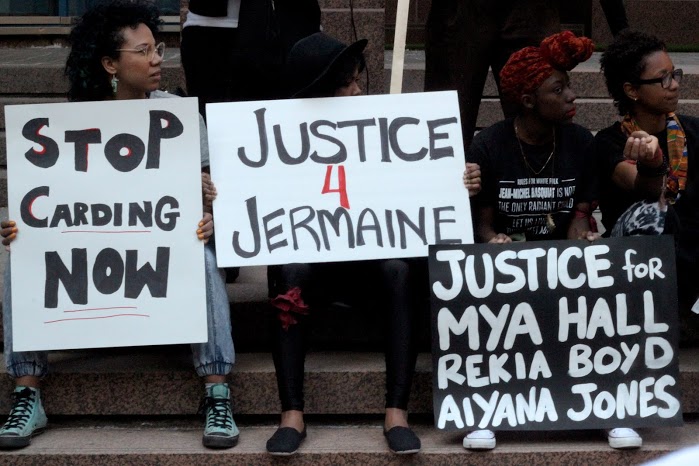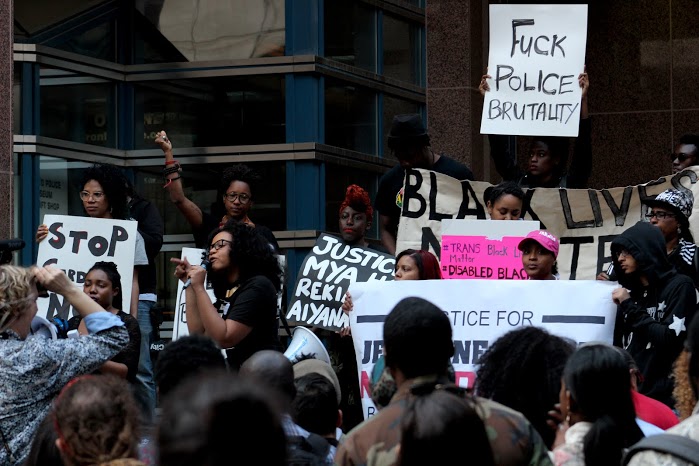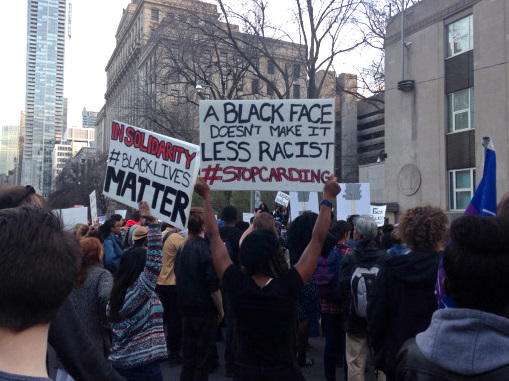On May 2 in Toronto, hundreds of protesters gathered in front of Toronto Police Headquarters, chanting “Black lives matter” as part of the action From Toronto to Baltimore, Black Lives Matter to show solidarity with Baltimore, draw attention to the practice of carding and demand their narratives be respected.
The action, coordinated by the Black Lives Matter: Toronto Coalition, was originally organized in response to the murder of Freddie Gray, a 25-year-old African-American man, in Baltimore, M.D. In the Sandtown-Winchester neighbourhood, in the early hours of April 12 2015, Gray was violently arrested and dragged into a van by officers. Witnesses told the Baltimore Sun that they had witnessed an officer pressing a knee into Gray’s neck, while another was bending his legs backwards.
After sustaining severe spinal injuries, Gray died on April 19 2015.

During the investigation of Gray’s death, the Baltimore Police Department suspended six officers with pay. However as of May 1 2015, Gray’s death has been ruled a homicide and Baltimore’s State Attorney’s office has stated that they have probable cause to file criminal charges against the six police officers involved.
The state’s attorney for Baltimore City, Marilyn Mosby, has gone on record admitting that the Baltimore police acted illegally and that Freddie Gray did not commit a crime.

While covering the protests, which are springing up all over the United States, the mainstream media has been quite crass in their presentation of the uprisings. The now-famous clip of Baltimore protesters telling Fox News anchor Geraldo Rivera and his crew to leave their city because they were “exploiting Black pain” is an illustration of how the media has been portraying these demonstrations.
As the Toronto to Baltimore demonstration was beginning Alex, one of the organizers in Black Lives Matter: Toronto Coalition, explained her feelings surrounding the media portrayal of the protests.
“In terms of the first couple of protests that we did, when we centralized Black bodies, there was a huge backlash. I don’t think our community is really depending on mainstream media as much anymore. We’re online and we’re checking in with one another.”

Organizers made clear that while the news of Freddie Gray’s death in Baltimore was upsetting, we can’t speak of police violence as though it’s solely an American issue.
“I think the biggest thing is that we know that it’s happening, we just don’t know to the degree. And, I think that was one of the biggest things that Black Lives Matter: Toronto Coalition tried to explain today. When we had the call with other [Black Lives Matter] organizations around the world the biggest thing to do was to make it central to your people, to your community. And, one of the biggest things [in Toronto] is carding,” stated Alex.
“Carding” is a system wherein law enforcement stop individuals on the street, question them, and ask for documentation. Toronto’s newly appointed chief of police, Mark Saunders, recently disappointed civil rights advocates when he claimed that abolishing the practice of carding would lead to more crime. Mid-protest, organizers inquired as to what protesters thought of Toronto’s first African-Canadian police chief.
Booing ensued. The crowd then began to chant “If I’m free to go, let me know!” since civil rights advocates argue it is within your full right to refuse to engage with law enforcement during a carding stop. The Toronto Star did an analysis of carding in Toronto that proved that Black men aged 15-24 are stopped 2.5 times more than white men the same age.

In addition to words from organizers, the crowd also heard the story of Jermaine Carby, a young Black man who was murdered by Peel Regional Police on September 24 2014. The Justice for Jermaine Carby Committee handed out tiny fliers outlining the case. One point on the back of the flier states that officers were reportedly heard telling Carby to “drop the knife” although no witnesses reported seeing one.
Organizer, Alex, also made very clear that Black Lives Matter: Toronto Coalition is dedicated to diverse representation of the Black community to ensure that everyone receives support.
“We are a collective that is made up of a lot of Black folk. We have Black queer women on our board, Black trans women, cis men, Black queer men — and that’s still not enough. And we’re trying to expand what that looks like, with what our community looks like, to make sure everyone’s represented.”
She added, “One of the biggest things is that people show up for Black men. Rekia Boyd’s rally only got about 50 people. But today, we’re out here for Freddie Gray, but we’re going to name the names of: Mya Hall, Miriam Carey, and Aiyana Stanley-Jones. We’ve got to make sure people know that we’re dying, too.”

The demonstrators marched from Toronto Police Headquarters at 40 College St, along College, and down University Ave to the United State Consulate. All the while protesters chanted, “Hands up! Don’t shoot!” and “No justice! No peace! No racist police!”
Ending with a sit-in in front of the U.S. Consulate, words from Alex’s statement rang true. She made clear that organizing has purposes beyond simply raising awareness.
“We can connect [people] with what’s happening, let them hear the stories, let them share stories, let them heal and be with one another so that we can understand, in a very healing and communicative way, how we can actually combat this.”
Ashley Splawinski is a student at the University of Toronto. Previously, Ashley worked as a producer and host of News Now on CHRY 105.5 FM covering Canadian social, political, and environmental issues. You can visit her personal blog www.lionpolitics.tumblr.com and follow her on twitter @asplawinski.
Photos: Ashley Splawinski



